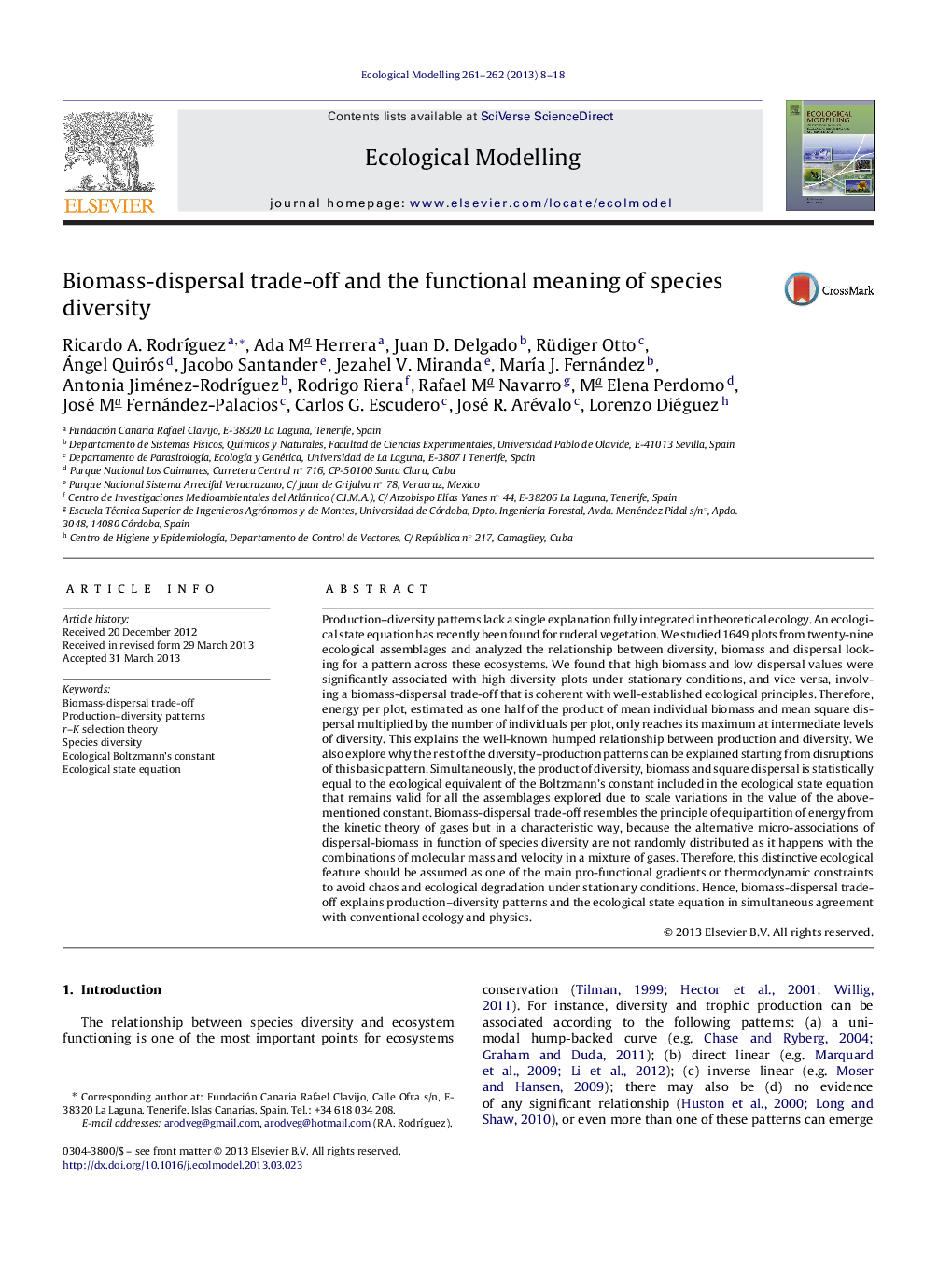| کد مقاله | کد نشریه | سال انتشار | مقاله انگلیسی | نسخه تمام متن |
|---|---|---|---|---|
| 6297141 | 1617484 | 2013 | 11 صفحه PDF | دانلود رایگان |
عنوان انگلیسی مقاله ISI
Biomass-dispersal trade-off and the functional meaning of species diversity
ترجمه فارسی عنوان
معامله با توزیع زیست توده و معنای کارکرد تنوع گونه ها
دانلود مقاله + سفارش ترجمه
دانلود مقاله ISI انگلیسی
رایگان برای ایرانیان
ترجمه چکیده
الگوهای تنوع تولید بدون توضیح تک کاملا به محیط زیست نظری پیوست. معادله حالت اکولوژیکی اخیرا برای پوشش گیاهی ردیف شده است. ما 1649 توطئه از بیست و نه مجموعه اکولوژیکی را مورد مطالعه قرار دادیم و رابطه بین تنوع، زیست توده و پراکندگی را بررسی کردیم که به دنبال یک الگوی در میان این اکوسیستم ها بود. ما دریافتیم که مقادیر بیوماس بالا و پراکندگی پایین به طور قابل توجهی با تکه های تنوع زیادی در شرایط ثابت همراه هستند و بالعکس، شامل یک توزیع پراکندگی زیست توده می شود که منطبق با اصول اصول زیست محیطی است. بنابراین، انرژی در هر قطعه، تخمین زده می شود به عنوان یک نیمی از محصول میانگین مایع فردی و متوسط پراکندگی مربع ضرب شده توسط تعداد افراد در هر طرح، تنها به حداکثر خود را در سطوح متوسط از تنوع می رسد. این توضیح می دهد رابطه شناخته شده بین تولید و تنوع است. ما همچنین بررسی می کنیم که چرا بقیه الگوهای تولید تنوع را می توان از اختلالات این الگوی اولیه توضیح داد. همزمان، محصول تنوع، زیست توده و پراکندگی مربع به لحاظ آماری برابر با معادل اکولوژیک ثابت بولتزمان است که در معادله حالت اکولوژیکی موجود است که برای تمام مجموعه هایی که با توجه به تغییرات مقیاس در ارزش ثابت ذکر شده مورد بررسی قرار می گیرد. تعادل زیست توده پراکندگی شبیه اصل هماهنگ سازی انرژی از نظریه جنبشی گازها است، اما به روش خاصی، به این دلیل که ترکیب های متمایز جایگزینی از پراکندگی-بیوماس در عملکرد تنوع گونه ها به طور تصادفی توزیع نمی شود، زیرا با ترکیبات اتفاق می افتد از جرم و سرعت مولکولی در مخلوط گازها. بنابراین، این ویژگی اکولوژیکی متمایز باید به عنوان یکی از اصلی ترین شیب های کاربردی یا محدودیت های ترمودینامیکی برای جلوگیری از هرج و مرج و تخریب زیست محیطی در شرایط ثابت فرض شود. بدین ترتیب، تفکیک پراکندگی زیست توده، الگوهای تنوع تولید و معادله حالت اکولوژیکی را در توافق همزمان با محیط زیست و فیزیک متعارف توضیح می دهد.
موضوعات مرتبط
علوم زیستی و بیوفناوری
علوم کشاورزی و بیولوژیک
بوم شناسی، تکامل، رفتار و سامانه شناسی
چکیده انگلیسی
Production-diversity patterns lack a single explanation fully integrated in theoretical ecology. An ecological state equation has recently been found for ruderal vegetation. We studied 1649 plots from twenty-nine ecological assemblages and analyzed the relationship between diversity, biomass and dispersal looking for a pattern across these ecosystems. We found that high biomass and low dispersal values were significantly associated with high diversity plots under stationary conditions, and vice versa, involving a biomass-dispersal trade-off that is coherent with well-established ecological principles. Therefore, energy per plot, estimated as one half of the product of mean individual biomass and mean square dispersal multiplied by the number of individuals per plot, only reaches its maximum at intermediate levels of diversity. This explains the well-known humped relationship between production and diversity. We also explore why the rest of the diversity-production patterns can be explained starting from disruptions of this basic pattern. Simultaneously, the product of diversity, biomass and square dispersal is statistically equal to the ecological equivalent of the Boltzmann's constant included in the ecological state equation that remains valid for all the assemblages explored due to scale variations in the value of the above-mentioned constant. Biomass-dispersal trade-off resembles the principle of equipartition of energy from the kinetic theory of gases but in a characteristic way, because the alternative micro-associations of dispersal-biomass in function of species diversity are not randomly distributed as it happens with the combinations of molecular mass and velocity in a mixture of gases. Therefore, this distinctive ecological feature should be assumed as one of the main pro-functional gradients or thermodynamic constraints to avoid chaos and ecological degradation under stationary conditions. Hence, biomass-dispersal trade-off explains production-diversity patterns and the ecological state equation in simultaneous agreement with conventional ecology and physics.
ناشر
Database: Elsevier - ScienceDirect (ساینس دایرکت)
Journal: Ecological Modelling - Volumes 261â262, 24 July 2013, Pages 8-18
Journal: Ecological Modelling - Volumes 261â262, 24 July 2013, Pages 8-18
نویسندگان
Ricardo A. RodrÃguez, Ada Mª Herrera, Juan D. Delgado, Rüdiger Otto, Ángel Quirós, Jacobo Santander, Jezahel V. Miranda, MarÃa J. Fernández, Antonia Jiménez-RodrÃguez, Rodrigo Riera, Rafael Mª Navarro, Mª Elena Perdomo,
